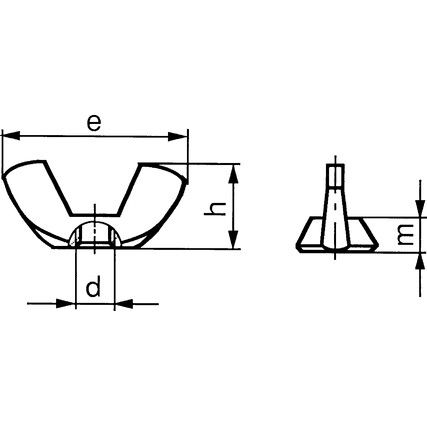Wing Nuts
Easily and endlessly fasten your workpieces quickly and without the need for tools with wing nuts. Cromwell offer a curated range of wing nuts across a variety of sizes and specifications from the leading brand Qualfast®.
What are wing nuts?
Wing nuts (or sometimes called butterfly nuts) are a type of fastener with protruding metal "wings" that allow for fastening using just your hands. They can exert a relatively high amount of clamping force without the need for tool use or heat treatment.
When are wing nuts used?
Wing nuts can be used in a wide variety of applications, and due to their ability to be fastened by hand, allows them to be used quickly and offers high adjustability. Wing nuts are often used in carpentry and other industries where quick hand tensioning and clamping is required. Due to their easy to install and uninstall nature, they should not be used on load bearing or vibrating applications.
Considerations when choosing wing nuts
• Thread size - It is important to get the right thread size wing nut for the application to ensure proper fitment and clamping force.
• Height - It is important to consider the height of the thread nut to ensure it will not affect the clearance with other pieces when installed. Larger wings can also aid in fastening as it allows for a larger surface to apply torque.
• Width - The width must be an important consideration when choosing wing nuts as they may need to fit into recessed holes or affect clearance with other pieces when installed. Larger wings can also aid in fastening as it offers a larger surface to apply torque.
• Material - The wing nut material is an important consideration to ensure that there is suitability between the wing nut and surface. Additionally, steel wing nuts can provide a higher clamping force due to the hardness of the material.
Wing nuts jargon buster
We want to make it easy for you, so here are some key terms that will help you understand the range and applications a little better
What is DIN 314 and DIN 315?
DIN 314 and DIN 315 are international standards to specify the shape and size of wing nuts. DIN 314 is for wing nuts with edged wings, whereas DIN 315 is for wing nuts with rectangular wings. Having international standards such as DIN 314 and DIN 315 ensures that the wing nuts provide the required amount of clamping safely.
FAQs
How do you remove wing nuts?
Wing nuts are designed to be tightened and loosened by hand in a clockwise and an anti-clockwise motion respectively. There may be some situations where wing nuts become stuck due to contamination or corrosion. In these situations, a flat head screwdriver and hammer will be required to exert enough force to dislodge the wing nut and allow be removed by hand.
What is the advantage of wing nut?
One of the main advantages of wing nuts is the lower torque requirement to fasten, allowing them to be tighten by hand. Wing nuts tend to not need heat treatment during application and can be used with or without washers.

